Sometimes you just have to know what to look for
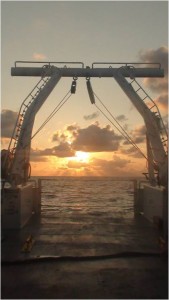 The day began early again, with Dr. Jim McManus, Bill Fanning, and me out to deploy the CTD at 06:15 local time. The ship had been circling the Lander throughout the night, as a mother bear would watch out for her cub. On the fast brightening horizon, you could just make out the strobe on the Lander’s beacon amidst the alien Morse code that the distant oil rigs were flashing.
The day began early again, with Dr. Jim McManus, Bill Fanning, and me out to deploy the CTD at 06:15 local time. The ship had been circling the Lander throughout the night, as a mother bear would watch out for her cub. On the fast brightening horizon, you could just make out the strobe on the Lander’s beacon amidst the alien Morse code that the distant oil rigs were flashing.
As soon as the water chemistry was recorded, the In-Situ pumps were set-up and sent in the water next by Dr. Maiti and Dr. 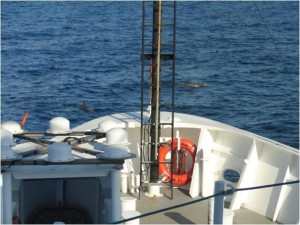 Severmann. While the pumps were running at their three respective depths, the scientists and crew enjoyed breakfast in the mess. A quick trip to the bridge after chow offered up the perfect vantage point to catch our pod of dolphins playing in the wake by the bow. You could even hear them whistling and squeaking to each other when we were waking up in our bunks. Then it was back out to recover the pumps and get everyone to their stations for the third Lander recovery of this expedition.
Severmann. While the pumps were running at their three respective depths, the scientists and crew enjoyed breakfast in the mess. A quick trip to the bridge after chow offered up the perfect vantage point to catch our pod of dolphins playing in the wake by the bow. You could even hear them whistling and squeaking to each other when we were waking up in our bunks. Then it was back out to recover the pumps and get everyone to their stations for the third Lander recovery of this expedition.
Pulling in these one-of-a-kind, fine-tuned instruments is no simple task. To the outsider, it may appear that there is a swivet on deck. However, the scientists and crew meet with the Captain and discuss a plan of attack. Each person has a role and responsibility to maintain, while monitoring for anything out of place and watching out for their own safety. Not to mention, they are working in an environment full of extreme variables: wind, waves, currents, weather changes. The whole operation requires teamwork and precise communication; it is a very delicate dance.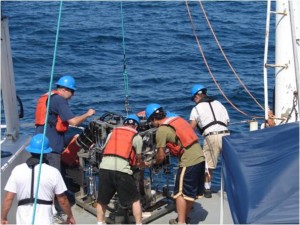
Once the Lander was safely secured on deck, it was off to the next station (as a side note: a “station” constitutes a location where a Lander is deployed). In the meanwhile, the science team is adding to their data hourly. Dr. Severmann is constantly recording the levels of Iron in the pore water. She has noted that though there are high levels of this element in the water from the samples, it is not at the level they had anticipated. It is still early in the results to report specifics, but for now, the deeper levels of samples from our hypoxic waters are filled with iron. Dr. Doug Hammond came in from the cold van to share with us a finding from his core samples. It turns out they have consistently found lag deposits several centimeters down in each of the sample, with lighter substrate settled on top. Lag deposits are created from a high current or large storm event, when the waters shift the lighter sediments and leave behind a heavy layer of substrate (in this case, shells and rock. The most likely culprits of this are the more recent hurricanes to hit the Gulf of Mexico, Katrina and Ivan come to mind.
Upon reaching our next destination, to be named Station #4, we ran the routine CTD recon deployment. Strangely though, the waters were not hypoxic at all. In fact, the samples were contradicting the current data from recently published charts of the hypoxic plume. So it was off in search of far less oxygenated waters. Running samples like this takes planning and input, and is constantly evolving. The past year and a half has been leading up to these three weeks of sampling and study, the conditions need to be just right to get the best collections possible because when you are back at the lab, it is too late to go back out. Finally, after the fifth try with the CTD we found waters with suitable conditions for further sampling of hypoxia. The last two tests run were the Multi-corer and GO-Flos, which wrapped up around 9pm.
Fortunately, we had time to turn our attention to the west as the sun was setting. The long-fabled, at least to most on this ship, “green-flash” was spotted last night and the conditions today were very similar. As the sun slipped past the oil rig and horizon, there was a collective, quiet gasp from those looking on: the green flash. This photo was not altered at all. In order for it to appear, despite what Pirates of the Caribbean has taught us, there needs to be specific weather parameters; the right temperature, air quality, humidity, and a clear horizon all play a part. Whether it is finding specific waters in an enormous area, monitoring for trace micro-nutrients, or looking to the west for the green flash, sometimes you just have to know what to look for.


 August 5, 2011
August 5, 2011 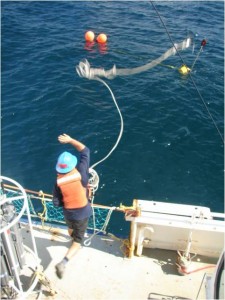
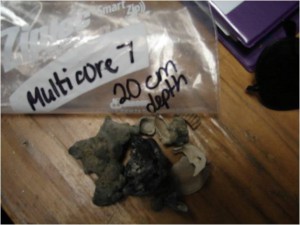
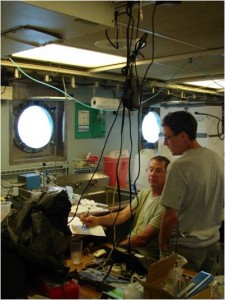
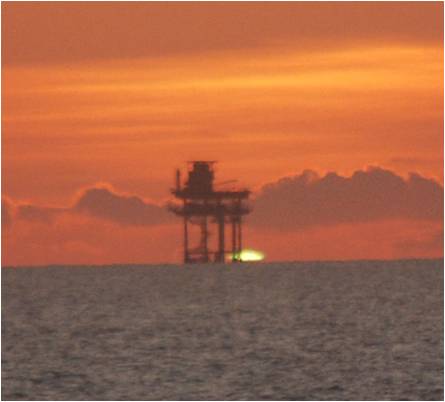







Recent Comments